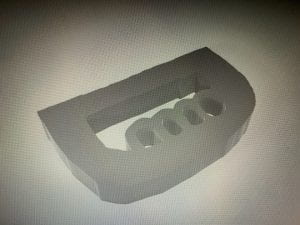When we had our first FaceTime I honestly didn’t really know what to expect. I had  never really heard of Huntington’s before and I didn’t really know what was gonna happen. We soon realized we wanted to help Tim get off the couch. We tried a few things out but nothing was really working and we had a lot of the same ideas as the other groups. So we decided to think outside of the box, and came up with an idea to help him hold a cup. It took us a while to think of how it would work. But we soon came up with a design, and printed it off. We realized it was too small so we asked Mr Robinson to get the measurements of Tim’s hands to give us a better idea of what size it should be.
never really heard of Huntington’s before and I didn’t really know what was gonna happen. We soon realized we wanted to help Tim get off the couch. We tried a few things out but nothing was really working and we had a lot of the same ideas as the other groups. So we decided to think outside of the box, and came up with an idea to help him hold a cup. It took us a while to think of how it would work. But we soon came up with a design, and printed it off. We realized it was too small so we asked Mr Robinson to get the measurements of Tim’s hands to give us a better idea of what size it should be.
 We connected with Nikola and Tim. We needed to know if Tim liked coffee/tea to see if was even worth making. We learnt he does so we could go along with our plan. We als
We connected with Nikola and Tim. We needed to know if Tim liked coffee/tea to see if was even worth making. We learnt he does so we could go along with our plan. We als o had to ask Tim if we could get a rough measurement of his hands to give us a better idea of how big we needed to make it.
o had to ask Tim if we could get a rough measurement of his hands to give us a better idea of how big we needed to make it.
We ended up making a handle that we are able to glue onto a cup. We had to really think through how it was going to work. We ended up with a sort of semi circle with a flat edge that could be glued on. We ended up putting finger holes in. We actually had to print off 2 because our first one ended up being too small.
A few skills I have learned and developed would be working with other people especially ones I dont really know too well. It also learnt how to use new things on my computer. Before this I didn’t even know what teams was and now I feel pretty comfortable using it. Another one is TinkerCad and understanding how 3D printers work a bit more.
I think the skills I have learnt could also be used in other classes not just science because working with others is a life skill I feel like. Also just getting my work done because I know other people are relying on it. I feel like I didn’t exactly meet the goals I set for myself for two reasons. 1 being i thought I was making something for the couch and 2 being when I made them I didn’t completely understand what we were doing fully. I definitely met some of them and looking back at the experience I am happy with what I accomplished.
I feel like I didn’t exactly meet the goals I set for myself for two reasons. 1 being i thought I was making something for the couch and 2 being when I made them I didn’t completely understand what we were doing fully. I definitely met some of them and looking back at the experience I am happy with what I accomplished.
The collaboration went pretty good, me and my partner both did our fair share, and i’m happy we got to do it in groups because it just gave us different points of view to look at stuff and someone to go to if you needed help. It also cut the work load in half kind of.
We did well on thinking of a unique idea no one else thought of that hopefully will make Tim’s life a little bit easier. I think that there is a coule things we could have done better. We should have used the class time we got a little bit better. Not that we fooled around all the time but I think we kind of left some final things to the last minute. We also should have asked more questions when we didn’t understand something because it would have made everything a lot easier on us.
I actually really enjoyed the connection based learning because it wasn’t boring, like sometimes taking notes is or something. We also got to guid ourselves in a way, there wasn’t really a criteria to follow. It also made you feel like you are helping someone witch I hope something we made does help Tim and make his life a little bit easier. I really enjoyed it and I hope I get to do something like it again!





